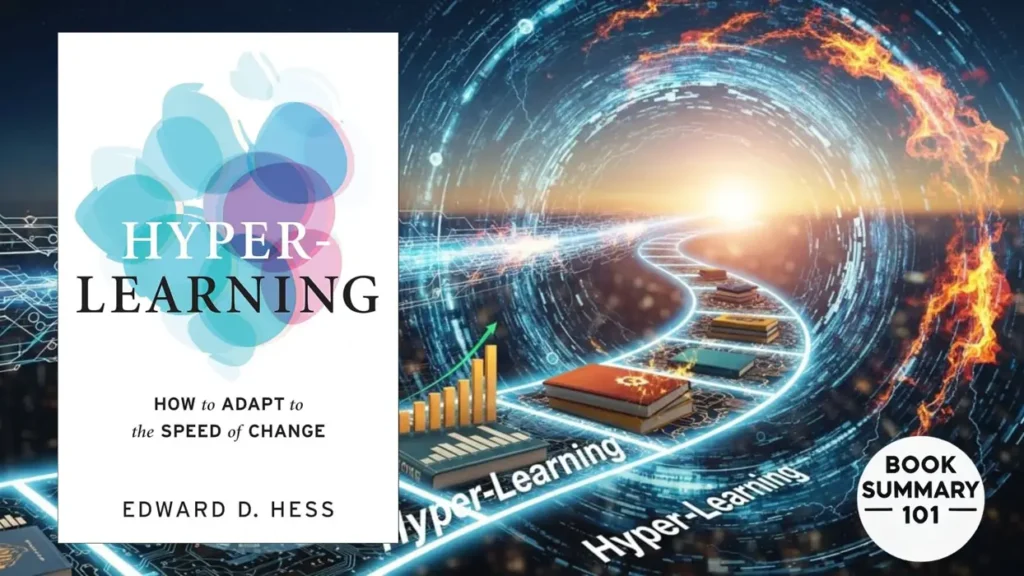Let’s face it—our world is spinning faster than ever. The pace of change is relentless, and the old ways of learning, working, and living just don’t cut it anymore. Enter Hyper-Learning: How to Adapt to the Speed of Change by Edward D. Hess, a guidebook for thriving in the 21st century. This book isn’t just about surviving change; it’s about flourishing in it.
Today, I’m breaking down the key insights from this transformative book in a way that feels like a conversation with a friend. Ready? Let’s dive in.
Why Read This Book?
We all know someone who’s stuck in their ways—afraid of new technologies or resistant to change. Maybe that’s even been you or me at some point! Hyper-Learning is a wake-up call. Hess makes it clear: adaptability is the new superpower.
But here’s the kicker—adaptability doesn’t just mean picking up a new skill every now and then. It’s about rewiring how you think, learn, and collaborate daily. Whether you’re a business leader, a teacher, or simply someone who wants to stay relevant, this book offers practical steps to help you grow.
The Big Idea: What Is Hyper-Learning?
At its core, Hyper-Learning is about creating environments—both personal and organizational—that foster continuous learning. Hess argues that being a lifelong learner isn’t optional anymore. The world’s top companies want people who can think critically, collaborate effectively, and unlearn outdated habits.
Hyper-Learning has three pillars:
- Mindset: Developing a growth-oriented, humble mindset.
- Processes: Adopting habits and practices that fuel curiosity and creativity.
- Behaviors: Building psychological safety and deep connections with others.
It’s like leveling up your brain for a world where AI and automation dominate.
How to Train Your Mind for the Future
Let’s break down some of the most practical strategies from Hyper-Learning that you can put into action. These aren’t just theoretical ideas—they’re small, actionable changes that can have a big impact on how you think, work, and grow.
Practice Reflective Listening
How often do you truly listen? Most of us spend conversations planning what we’re going to say next, waiting for our turn to talk. Hess challenges us to flip this script by practicing reflective listening.
Here’s how it works:
- Be Present: When someone is speaking, don’t multitask or let your mind wander. Focus entirely on their words, tone, and body language.
- Reflect Back: Instead of responding immediately with your thoughts, summarize what the other person said. For example, “So what I’m hearing is that you’re feeling overwhelmed by the project deadline—am I getting that right?”
- Ask Open Questions: Build on their thoughts with questions like, “What do you think could help ease that stress?”
This simple but powerful habit can transform your relationships at work and at home. It shows respect, builds trust, and often leads to deeper insights. People feel heard, and you gain a better understanding of their perspective.
Create a Learning Environment
Learning doesn’t just happen—it’s something you have to design into your daily life. Hess emphasizes the importance of building an environment that constantly stimulates curiosity and growth.
Here’s how to start:
- Audit Your Inputs: What’s your “mental diet”? Swap mindless social media scrolling for content that challenges your thinking, like thought-provoking podcasts, books, or TED Talks.
- Find a Learning Buddy: Partner with someone who shares your thirst for knowledge. Discuss what you’re learning and hold each other accountable.
- Embrace Discomfort: Growth rarely happens in your comfort zone. Seek out opinions that differ from yours, and don’t shy away from constructive criticism.
Example: Set aside 20 minutes a day to explore a topic outside your field. If you’re a marketer, read about quantum physics. If you’re a teacher, dive into entrepreneurship. This cross-disciplinary learning can spark creativity and innovation.
Embrace Failure as a Learning Tool
If you’re afraid to fail, you’re holding yourself back. Hess argues that failure is one of the best teachers, but only if you approach it with the right mindset.
Here’s how to “fail well”:
- Reframe Failure: Instead of seeing it as a personal flaw, view it as feedback. Ask yourself, “What didn’t work, and what can I do differently next time?”
- Run Small Experiments: Break big risks into smaller, manageable steps. For example, if you’re launching a new product, test it with a small group first and gather feedback before scaling up.
- Debrief Your Failures: After a setback, take time to reflect. Hess recommends asking three key questions:
- What went well?
- What didn’t go as planned?
- What will I do differently moving forward?
When you embrace failure as a necessary part of growth, you free yourself from the fear of making mistakes. This openness leads to faster learning and more creative problem-solving.
Cultivate a “Beginner’s Mindset”
You’ve probably heard the phrase “beginner’s mindset,” but Hess takes it to a whole new level. This is about letting go of what you think you know and approaching every situation with curiosity and humility.
To cultivate this mindset:
- Ask More Questions: Even if you think you know the answer, ask. Questions like “Why is this happening?” or “What am I missing?” open up new avenues of thinking.
- Challenge Assumptions: Don’t take things at face value. Regularly question your own beliefs and processes. Why do you do things a certain way? Is there a better way?
- Be Open to Feedback: Instead of bristling at criticism, lean into it. Treat feedback as a gift—it’s someone helping you see blind spots you might have missed.
Example: Imagine you’re leading a team meeting. Instead of dominating the conversation with your ideas, start by asking your team for their input. You might be surprised at the innovative solutions they bring to the table.
Foster Psychological Safety
Hess highlights the importance of creating an environment where people feel safe to speak up, share ideas, and make mistakes. Without psychological safety, true collaboration and innovation are impossible.
Here’s how to foster it:
- Lead with Vulnerability: Share your own mistakes and what you’ve learned from them. This sets the tone that it’s okay to be imperfect.
- Reward Effort, Not Just Results: Celebrate the process, even if the outcome isn’t perfect. For example, if a teammate comes up with a creative idea that doesn’t pan out, acknowledge their effort and creativity.
- Encourage Debate: Invite diverse perspectives and create space for healthy disagreements. Say things like, “I’d love to hear a different take on this—any thoughts?”
Psychological safety isn’t just for leaders. Even if you’re not in a leadership role, you can contribute by being supportive, giving constructive feedback, and valuing others’ input.
Build Daily Learning Habits
Hyper-Learning isn’t a one-time effort; it’s a lifestyle. The key is consistency—small, daily habits that compound over time.
Try this:
- Start a Learning Journal: Dedicate 10 minutes a day to jotting down what you learned, questions you have, and ideas you want to explore further.
- Block Time for Deep Work: Schedule uninterrupted time to focus on learning or tackling complex problems. Turn off distractions and immerse yourself.
- Reflect Regularly: At the end of each week, ask yourself: “What did I learn? Where did I grow? What challenges am I excited to tackle next week?”
These habits help you stay on track and ensure that you’re always moving forward, even when life gets busy.
By incorporating these strategies into your daily routine, you’ll not only adapt to the speed of change but thrive in it. Remember, the goal isn’t perfection—it’s progress. Which of these habits will you start with? Share your thoughts below—I’d love to hear your take!
Real-Life Examples
Hess doesn’t just throw theories at you—he backs them up with compelling stories.
The Case of a CEO Who Let Go of Ego
One of my favorite examples is about a CEO who realized his old-school, “know-it-all” approach was hurting his company. With Hess’s principles, he transformed himself into a better listener and problem-solver. His team thrived because he learned to value diverse perspectives.
AI and Human Collaboration at a Law Firm
Hess also shares a story of a law firm integrating AI into its processes. Instead of resisting, the lawyers embraced technology as a partner. They shifted their focus to higher-level thinking—crafting better strategies for clients rather than wasting time on mundane tasks.
The result? More efficiency, happier employees, and better client outcomes.
Join the Conversation!
This book left me buzzing with ideas—and I’m curious to hear yours. Have you ever struggled to adapt to change? What’s your go-to strategy for learning something new?
Drop a comment below or share this post with someone who could use a dose of Hyper-Learning. Let’s keep the conversation going, because if there’s one thing this book taught me, it’s that we grow better together.
Ready to unlock your superpower? Grab a copy of Hyper-Learning and let the transformation begin!
5 powerful quotes from Hyper-Learning by Edward D. Hess
📖 “In a world being reshaped by technology, your ability to continuously learn, unlearn, and relearn will be your competitive advantage.”
This reminds us that knowledge isn’t static—what worked yesterday might not work tomorrow. Success belongs to those who adapt.
👉 Simple terms: The faster you can update your skills, the more valuable you’ll be.
📖 “Ego is the enemy of learning. To truly grow, you must replace ‘I know’ with ‘I want to learn.’”
Hess emphasizes humility as the foundation of Hyper-Learning. Clinging to being right blocks new ideas.
👉 Simple terms: Stay curious, not cocky—growth comes from openness.
📖 “Fear of failure kills innovation. Safe mistakes are the stepping stones to progress.”
Failure isn’t the end—it’s feedback. By reframing mistakes as experiments, you create space for creativity.
👉 Simple terms: Don’t fear failing; use it to move forward.
📖 “Psychological safety is not optional—it’s the oxygen of collaboration.”
Teams thrive when people feel safe to share, debate, and take risks without judgment.
👉 Simple terms: People do their best work when they feel respected and heard.
📖 “Hyper-Learning is not a skill you add to your life—it’s a way of living your life.”
This final quote captures the heart of the book. It’s not about one-time learning but making adaptability and curiosity your daily habits.
👉 Simple terms: Learning isn’t an event, it’s a lifestyle.


